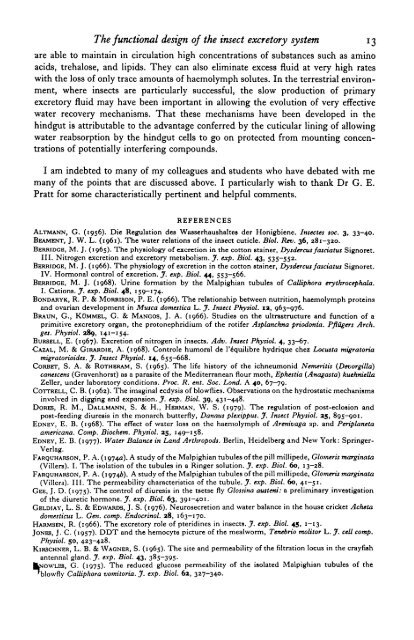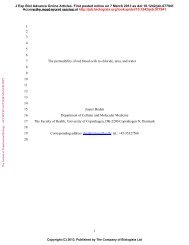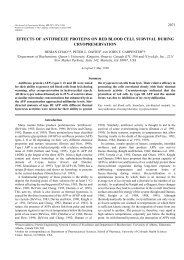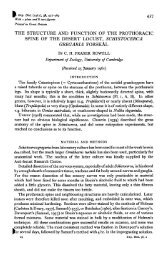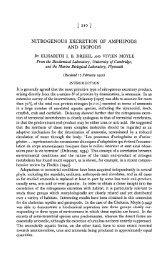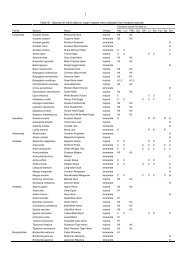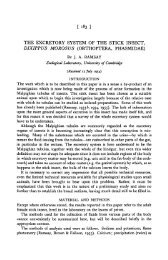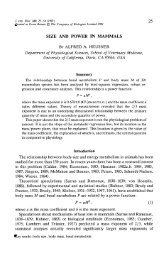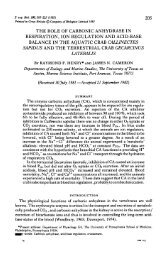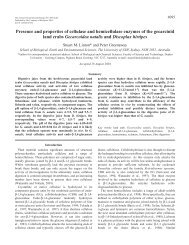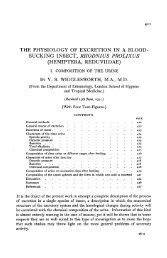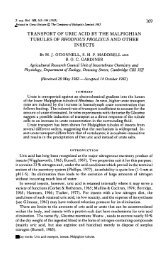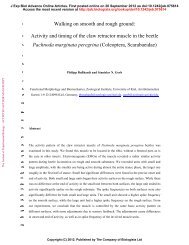the functional design of the insect excretory system - The Journal of ...
the functional design of the insect excretory system - The Journal of ...
the functional design of the insect excretory system - The Journal of ...
Create successful ePaper yourself
Turn your PDF publications into a flip-book with our unique Google optimized e-Paper software.
<strong>The</strong> <strong>functional</strong> <strong>design</strong> <strong>of</strong> <strong>the</strong> <strong>insect</strong> <strong>excretory</strong> <strong>system</strong> 13<br />
^re able to maintain in circulation high concentrations <strong>of</strong> substances 9uch as amino<br />
acids, trehalose, and lipids. <strong>The</strong>y can also eliminate excess fluid at very high rates<br />
with <strong>the</strong> loss <strong>of</strong> only trace amounts <strong>of</strong> haemolymph solutes. In <strong>the</strong> terrestrial environment,<br />
where <strong>insect</strong>s are particularly successful, <strong>the</strong> slow production <strong>of</strong> primary<br />
<strong>excretory</strong> fluid may have been important in allowing <strong>the</strong> evolution <strong>of</strong> very effective<br />
water recovery mechanisms. That <strong>the</strong>se mechanisms have been developed in <strong>the</strong><br />
hindgut is attributable to <strong>the</strong> advantage conferred by <strong>the</strong> cuticular lining <strong>of</strong> allowing<br />
water reabsorption by <strong>the</strong> hindgut cells to go on protected from mounting concentrations<br />
<strong>of</strong> potentially interfering compounds.<br />
I am indebted to many <strong>of</strong> my colleagues and students who have debated with me<br />
many <strong>of</strong> <strong>the</strong> points that are discussed above. I particularly wish to thank Dr G. E.<br />
Pratt for some characteristically pertinent and helpful comments.<br />
REFERENCES<br />
ALTMANN, G. (1956). Die Regulation des Wasserhaushaltea der Honigbiene. Insectes soc. 3, 33-40.<br />
BEAMENT, J. W. L. (1961). <strong>The</strong> water relations <strong>of</strong> <strong>the</strong> <strong>insect</strong> cuticle. Biol. Rev. 36, 281-320.<br />
BERRIDGH, M. J. (1965). <strong>The</strong> physiology <strong>of</strong> excretion in <strong>the</strong> cotton stainer, Dysdercui fatciatus Signoret.<br />
III. Nitrogen excretion and <strong>excretory</strong> metabolism. J. exp. Biol. 43, 535-552.<br />
BHRRIDGB, M. J. (1966). <strong>The</strong> physiology <strong>of</strong> excretion in <strong>the</strong> cotton stainer, Dysdercus fatciatut Signoret.<br />
IV. Hormonal control <strong>of</strong> excretion. J. exp. Biol. 44, 553—566.<br />
BERRIDGE, M. J. (1968). Urine formation by <strong>the</strong> Malpighian tubules <strong>of</strong> Calliphora erythrocephala.<br />
I. Cations. J. exp. Biol. 48, 159-174.<br />
BONDARYK, R. P. & MORRISON, P. E. (1966). <strong>The</strong> relationship between nutrition, haemolymph proteins<br />
and ovarian development in Musca domestica L. J. Insect Pkysiol. 13, 963-976.<br />
BRAUN, G., KOMMEL, G. & MANGOS, J. A. (1966). Studies on <strong>the</strong> ultrastructure and function <strong>of</strong> a<br />
primitive <strong>excretory</strong> organ, <strong>the</strong> protonephridium <strong>of</strong> <strong>the</strong> rotifer Asplanchna priodonia. PftUgers Arch.<br />
ges. Physiol. 289, 141—154.<br />
BURSELL, E. (1967). Excretion <strong>of</strong> nitrogen in <strong>insect</strong>s. Adv. Insect Physiol. 4, 33—67.<br />
•CAZAL, M. & GIRARDIE, A. (1968). Controle humoral de l'equilibre hydrique chez Locusta nrigratoria<br />
migratorioides. J. Insect Physiol. 14, 655-668.<br />
CORBET, S. A. & ROTHBRAM, S. (1965). <strong>The</strong> life history <strong>of</strong> <strong>the</strong> ichneumonid Nemeritis (Devorgilla)<br />
canexcens (Gravenhorst) as a parasite <strong>of</strong> <strong>the</strong> Mediterranean flour moth, Ephestia (Anagasta) kuehniclla<br />
Zeller, under laboratory conditions. Proc. R. ent. Soc. hand. A 40, 67—79.<br />
COTTRELL, C. B. (1962). <strong>The</strong> imaginal ecdysis <strong>of</strong> blowflies. Observations on <strong>the</strong> hydrostatic mechanisms<br />
involved in digging and expansion. J. exp. Biol. 39, 431-448.<br />
DORES, R. M., DALLMANN, S. & H., HERMAN, W. S. (1979). <strong>The</strong> regulation <strong>of</strong> post-eclosion and<br />
post-feeding diuresis in <strong>the</strong> monarch butterfly, Danaus plexippus. J. Insect Physiol. 25, 895-901.<br />
EDNEY, E. B. (1968). <strong>The</strong> effect <strong>of</strong> water loss on <strong>the</strong> haemolymph <strong>of</strong> Arenivaga sp. and Periplaneta<br />
americana. Comp. Biochem. Physiol. 25, 149—158.<br />
EDNEY, E. B. (1977). Water Balance in Land Arthropods. Berlin, Heidelberg and New York: Springer-<br />
Verlag.<br />
FARQUHARSON, P. A. (1974a). A study <strong>of</strong> <strong>the</strong> Malpighian tubules <strong>of</strong> <strong>the</strong> pill millipede, Glomeris marginata<br />
(Villers). I. <strong>The</strong> isolation <strong>of</strong> <strong>the</strong> tubules in a Ringer solution. J. exp. Biol. 60, 13-28.<br />
FARQUHARSON, P. A. (19746). A study <strong>of</strong> <strong>the</strong> Malpighian tubules <strong>of</strong> <strong>the</strong> pill millipede, Glomeris marginata<br />
(Viller3). III. <strong>The</strong> permeability characteristics <strong>of</strong> <strong>the</strong> tubule. J. exp. Biol. 60, 41-51.<br />
GEE, J. D. (1975). <strong>The</strong> control <strong>of</strong> diuresis in <strong>the</strong> tsetse fly Glossina autteni: a preliminary investigation<br />
<strong>of</strong> <strong>the</strong> diuretic hormone. J. exp. Biol. 63, 391-401.<br />
GELDIAY, L. S. & EDWARDS, J. S. (1976). Neurosecretion and water balance in <strong>the</strong> house cricket Acheta<br />
domesticus L. Gen. comp. Endocrinol. 28, 163—170.<br />
HARMSBN, R. (1966). <strong>The</strong> <strong>excretory</strong> role <strong>of</strong> pteridines in <strong>insect</strong>s. J. exp. Biol. 45, 1-13.<br />
JONES, J. C. (1957). DDT and <strong>the</strong> hemocyte picture <strong>of</strong> <strong>the</strong> mealworm, Tenebrio molitor L. J. cell comp.<br />
Pltysiol. 50, 423-428.<br />
KIRSCHNER, L. B. & WAGNER, S. (1965). <strong>The</strong> site and permeability <strong>of</strong> <strong>the</strong> filtration locus in <strong>the</strong> crayfish<br />
antennal gland. J. exp. Biol. 43, 385-395.<br />
fcNOWLES, G. (1975). <strong>The</strong> reduced glucose permeability <strong>of</strong> <strong>the</strong> isolated Malpighian tubules <strong>of</strong> <strong>the</strong><br />
'blowfly Calliphora vomitoria. J. exp. Biol. 6a, 327-340.


